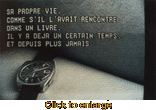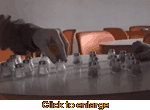|
|
8th Biennial of Moving Images
5 November - 12 December 1999
installations / films / videos / performances 3
Chantal Akerman (B)
John Baldessari (USA)
Alexandre Bianchini (CH)
Pierre Bismuth (F)
Ellen Cantor (USA)
Chris Dercon (B)
Cheryl Donegan (USA)
Yan Duyvendak (CH)
Fischli/Weiss (CH)
Jochen Gerz (D)
Jean-Luc Godard (CH)
Dominique Gonzalez-Foerster (F)
Philippe Grandrieux (F)
Thomas Hirschhorn (CH)
Korpys/Loeffler (D)
Tracey Moffatt (AUS)
Rainer Oldendorf (D)
Anna Sanders Films (F)
Fiona Tan (Indonésie)
Uri Tzaig (IL)
Andy Warhol (USA)
Programs and exhibition: André Iten, Director, with Simon Lamunière
Chantal Akerman (B)
opening night /program: Freddy Buache 2:
Sud, 1999, 70 min.
A documentary filmed in the South of the United States. This film is the conterpoint of one shot in the early 90s in Eastern Europe (D'Est, 1993). This is about a journey in the warm and humid Summer that make loose one's head.
John Baldessari (USA)
program John Baldessari:
Script, 1974, 50 min.
Title, 1972, 18 min.
Script was realised with students; it features a sequence of ten scenes, interpreted by seven couples, and edited according to three different patterns. Title juxtaposes minimalist images, edited without apparent logic; objects, characters, settings and dialogues are used to analyse the manipulation of signification.
Alexandre Bianchini (CH)
exhibition - first floor:
Le chemin des fins, 1998, installation
Do You Remember Tino Ranch, 1999, installation
With Le chemin des fins (The Ways to the Ends, 1998) and Do You Remember Tino Ranch (1999), Alexandre Bianchini has recently revealed certain ambitions for his art that fall more claerly within the domain of the cinema. His installations usually creates peculiar spaces by using multi-screen presentation.
Pierre Bismuth (F)
exhibition - 2nd floor:
Micro/Macro, 1999, installation
"The project consists of placing microphones on the outside of the building where the Center for Contemporary Images is located. These mikes will amplify niose at various points in the street that are relatively distant from one another, although always within a perimeter that is visible from the windows of the Center's second floor. I want people to spend time in front of the windows looking for the corresponding points between what they are offered aurally and the spectacle down in the street." (Excerpt from a letter addressed to Simon Lamunière, 12 July 1999)
Ellen Cantor (USA)
exhibition - first floor:
Madame Bovary's Revenge (The Lovers), 1995, 16 min.
program Ellen Cantor:
Within Haeven and Hell, 1996, 16 min.
Club Vanessa (The London Tape), 1996, 16 min.
Ode to Life (Minuet in G Major), 1997, 3 min.
Remember Me, 1999, 10 min.
Ellen Cantor's drawings and films are about women, about their desire and sexual life. Using images of well-known actresses taken in specifically intense moments (screaming, orgasm), she introduces personnal texts focusing on the various means of violence used in the production of images of the feminine body. The video Remeber Me as well as a selection of older tapes and drawings will be presented.
Chris Dercon (B)
program Chris Dercon:
Still/A Novel, 1996, 2 x 50 min.
Director of the Museum Bojmans Van Beuningen (Rotterdam) presents the documentary Still /A Novel directed by him in 1996 at the occasion of an exhibition in the Witte de With. This exhibition documented the 100 years of cinema by the means of photography; the two-part documentary features, a.o., Chantal Akeman, Matthew Barney, Raymond Bellour, Hartmut Bitomsky, Marcel Broodthaers, Jean-Marc Bustamante, James Coleman, Catherine David, Stan Douglas, Stanley Donen, Maria Eichhorn, Jean-Luc Godard, Douglas Gordon, Dan Graham, Chris Marker, Jeff Wall.
The program asks such questions as: Was cinema born too early or too late? Can cinema still create images in behalf of our civilization? Why has the cinema in recent years acknowledged defeat to the museums of modern art, or is the cinema simply retreating to these bulwarks out of fear for the loss of images? Should cinema reinvent itself as the "art by the grace of the other arts"? It is in any case a fact that many visual artists turn to the medium of film, in search of new images and stories as well as a larger public.
Cheryl Donegan (USA)
program Cheryl Donegan:
Head, 1993, 3 min.
Gracefulphatsheba, 1993, 6 min.
Guide, 1993, 2 min.
Makedream, 1993, 3 min.
Practice, 1994, 7 min.
Craft, 1994, 14 min.
Rehearsal, 1994, 14 min.
Artists + Models, 1998, 5 min.
Alive! Artist! Model! Pleasure!, 1998, 3 min.
Winner of the Prix de la Ville de Genève at he 7th Biennial of Moving Images (1997), the American artist will present a selection of her previous video works. What Donegan hangs on the walls or runs on monitors is a sort of finished product that we always suspect will pop up again in future art works.
Yan Duyvendak (CH)
performance:
Une soirée pour nous, 1999, 20 min.
The artist will make a performance during which he sits in front of the audience with a monitor on his knees, showing sequences of various films and TV excerpts (images of joy and happiness); the images are mute, and the artists speaks out and sings the dialogues.
Fischli/Weiss (CH)
program Fischli/Weiss:
Der geringste Widerstand, 1981, 30 min.
Der rechte Weg, 1983, 55 min.
In the 80's, Fischli & Weiss produced many films, a.o. Der geringste Widerstand (1981) and Der rechte Weg (1983). These early works are highly burlesque with the puppets characters set in beautiful touristic Swiss landscapes. Fischli/Weiss' work is emblematic of the use of many techniques and supports (sculpture, photograpy, use of found footage, editions and films).
Jochen Gerz (D)
Jochen Gerz and Georges Heck (Vidéo les Beaux-Jours, Stasbourg) have restored the entire video work of the artist, which will be exhaustively presented during the Biennial. Gerz produced "momuments" these last years (Sarrebrück and Hamburg) about the past of Germany and the necessary memory of it. He is also a poet who translated Ezra Pound, a photographer, and he has been making experimental videos since the 70's.
program:
- Jochen Gerz 1
Crier jusqu'à l'épuisement, 1972, 19 min.
Parler (Gerz/Sarkis), 1972, 21 min.
Exposition de Jochen GERZ à côté de la reproduction photographique, 1973, 17 min.
Lecture en italien de Thomas Jefferson, 1973, 12 min.
Du milieu aux bords, 1973, 4 min.
- Jochen Gerz 2
Snake Hoods & Dragon's Dreams, 1977, 23 min.
Marsyas (de la mort, de la vie), 1978, 9 min.
Der Malende Mund, 1979, 19 min.
Chinook, 1985, 36 min.
- Jochen Gerz 3
Purple cross for absent now, 1979/89, 18 min.
We are coming, 1980/81, 16 min.
Die Reise, 1981/82, 18 min.
Pionniers, 1982, 21 min.
- Jochen Gerz 4
Installations with video : Diese Worte sind mein Fleisch und mein Blut, Paris, 1971 - Der Kopf der M., Berlin, 1977 - Die griechische Witwe, Chur, 1978 - Das Lächeln Mona L.'s bleibt unerwidert, Münster, 1978, 8 min.,1997
Stadtfahrt, 1993, 60 min.
- Jochen Gerz 5
In case we meet, 1981, 18 min.
Video Opernhaus, 1982, 12 min.
Ti amo, 1985, 18 min.
Propos contenus à l'aube, 1989, 14 min.
L'autoportrait, 1975, 39 min.
Jean-Luc Godard (CH)
Godard was the first filmmaker to be honoured with a MOMA retrospective (1992), and his work is praised by filmmakers and critics as well as by the art world. His use of music, images and litterature is absolutely specific, and his Histoire(s) du cinéma, simultaneously published as a book and a video collection (Gallimard, 1998) create a new conception of memory.
program:
- Jean-Luc Godard et Anne-Marie Mieville 1
6 x 2 Sur et sous la communication : Photo et compagnie, 1976, 46 min.
6 x 2 Sur et sous la communication : Ya personne, 1976, 59 min.
- Jean-Luc Godard et Anne-Marie Mieville 2
6 x 2 Sur et sous la communication : Marcel, 1976, 56 min.
6 x 2 Sur et sous la communication : Nanas, 1976, 45 min.
- Jean-Luc Godard et Anne-Marie Mieville 3
6 x 2 Sur et sous la communication : Leçon de choses, 1976, 53 min.
6 x 2 Sur et sous la communication : Jacqueline et Ludo, 1976, 51 min.
- Jean-Luc Godard et Anne-Marie Mieville 4
6 x 2 Sur et sous la communication : Jean-Luc, 1976, 49 min.
6 x 2 Sur et sous la communication : Nous trois, 1976, 53 min.
- Jean-Luc Godard et Anne-Marie Mieville 5
6 x 2 Sur et sous la communication : Louison, 1976, 42 min.
6 x 2 Sur et sous la communication : Pas d'histoire, 1976, 57 min.
- Jean-Luc Godard et Anne-Marie Mieville 6
6 x 2 Sur et sous la communication : René, 1976, 54 min., France
6 x 2 Sur et sous la communication : Avant et après, 1976, 45 min.
- Jean-Luc Godard et Anne-Marie Mieville 7
France/tour/détour/deux/enfants Premier Mouvement : Obscur-Chimie, 1977-78, 26 min.
France/tour/détour/deux/enfants Deuxième Mouvement : Lumière-Physique, 1977-78, 26 min.
France/tour/détour/deux/enfants Troisième Mouvement : Connu-Géométrie-Géographie, 1977-78, 26 min.
France/tour/détour/deux/enfants Quatrième Mouvement : Inconnu-Technique, 1977-78, 26 min.
- Jean-Luc Godard et Anne-Marie Mieville 8
France/tour/détour/deux/enfants Cinquième Mouvement : Impression-Dictée, 1977-78, 23 min.
France/tour/détour/deux/enfants Sixième Mouvement : Expression-Français, 1977-78, 26 min.
France/tour/détour/deux/enfants Septième Mouvement : Violence-Grammaire, 1977-78, 27 min.
France/tour/détour/deux/enfants Huitième Mouvement : Désordre-Calcul, 1977-78, 26 min.
- Jean-Luc Godard et Anne-Marie Mieville 9
France/tour/détour/deux/enfants Neuvième Mouvement : Pouvoir-Musique, 1977-78, 26 min.
France/tour/détour/deux/enfants Dixième Mouvement : Roman-Economie, 1977-78, 26 min.
France/tour/détour/deux/enfants Onzième Mouvement : Réalité-Logique, 1977-78, 24 min.
France/tour/détour/deux/enfants Douxième Mouvement : Rêve-Morale, 1977-78, 26 min.
Dominique Gonzalez-Foerster (F)
videojockey:
La fin des films, 1999, 90 min.
program: Anna Sanders Films:
Riyo, 1999, 10 min.
The artist will make a performance: La fin des films (The End of Movies). It consists in a brief speech during which she talks about her reflection on architecture and cinema, followed by the screening of a variety of film ends, with a direct comment by the artist.
Philippe Grandrieux (F)
program Philippe Grandrieux:
Sombre, 1998, 112 min.
Philippe Grandrieux will present his first feature-film that was praised as a masterpiece by the French critic. Grandrieux has been working as a critic and director for INA and Arte for years before he decided to make his own movie. It is about a serial killer following the Tour de France and killing the women he meets; this very conventional story is a basis on which Grandrieux has created extraordinary esthetic images.
Thomas Hirschhorn (CH)
pogram Thomas Hirschhorn:
Vidéos intégrées/Integrated videos, 1995-99, 1999, 18 min.
Rencontre avec l'art contemporain, Coraly Suard-Hirschhorn, 1999, 50 min.
Since the 90's, Hirschhorn is making installations including video tapes. For the Biennial, he will present a compilation of the tapes made between 1995 and 1999. This project was initiated by Véronique Bacchetta, director of the Centre genevois de gravure conemporaine.
Rencontre avec l'art contemporain by Coraly Suard-Hirschhorn, will be a series of twelve documentaries on today's fast-moving artists. The first episode: Rencontre avec l'art contemporain n°1: Thomas Hirschhorn follows this artist in his exhibitions and interventions during 1999.
Korpys/Loeffler (D)
pogram Thomas Hirschhorn:
Studio 77, 1997, 5 min.
program Korpys/Loeffler:
Pentagon, 1997, 3 min.
United Nations Organisation, 1997, 5 min.
World Trade Center, 1997, 7 min.
Digging Deep, 1999, 42 min.
The two German artists will present a new installation with images and a mannequin. Korpys and Loeffler are interested in creating links beween places and their representations: sometimes they reconstruct spaces, sometimes they live in the spaces that they shoot. Their buildings as well as their images are like mental projections in real space.
Tracey Moffatt (AUS)
In her photographic series as well as in her films, Tracey Moffatt is concerned with autobiography, but also with aboriginal memory and colonialism, with identity and alienation, and she often focuses on feminist topics. Her movies are very oniric, and their specific aesthetic has contributed in placing Tracey Moffatt at the top of Australian avant-garde cinéma. Her complete filmic and video work is presented.
program:
Tracey Moffatt 1
Bedevil, 1993, 90 min.
Tracey Moffatt 2
Nice Colored Girls, 1987, 16 min.
Night Cries, 1989, 17 min.
Heaven, 1997, 28 min.
Lip, 1999, 7 min.
Rainer Oldendorf (D)
program Rainer Oldendorf:
Marco 1, Düsseldorf, 1995, 10 min.
Marco 2, Lyon, 1995, 12 min.
Marco 3, Tel Aviv, 1996, 12 min.
Marco 4, New York, 1997, 8 min.
Marco 5, Paris, 1997, 10 min.
Marco has been a film in progress since 1995, made with an old friend, Marco Galloplaying the role of the main character.From time to time Oldendorf presents installations or performances that are considered as steps in the making of the movie. As a teenager, Oldendorf worked in the Free Cinema in Lörrach near Basel, a place dedicated to experimental cinema; his commitment with media and film strategies started there.
Anna Sanders Films (F)
program Anna Sanders FIlms:
Blanche-Neige Lucie, Huygue Pierre, 1998, 4 min.
Riyo, Gonzalez-Foerster Dominique, 1999, 10 min.
Stanwix, De Meaux Charles, 1999, 18 min.
Le pont du trieur, De Meaux Charles et Parreno Philippe, 1999, 74 min.
The artists working under the label Anna Sanders films create a completely independant production and distribution network for their films.
Fiona Tan (Indonésie)
program: Hou Hanru carte blanche:
May you live in interesting times, 1997, 60 min.
exhibition - first floor:
Facing forward, 1999, 11 min.
Her 60-minute documentary film May you live in interesting times is a project in which, for three years, she travelled to visit her family members spread all around the world because of the anti-Chinese turmoil in Indonesia in the 1960s. Using a sophisticated and emotional technique of editing, Tan states "I aim with this project to investigate and hopefully deepen the current discussion of such hashed terms as: multiculturaly, migration and transgression."
In Facing forward, Tan puts the audience into concentrated, face-to-face confrontation with carefully selected silent film footage of a colonial documentary shot in "foreign and exotic" countries. She creates a specific space in which "moments of meeting, not just as meeting of individuals, but of cultures, ideas and times" are brought about.
Uri Tzaig (IL)
program Uri Tzaig:
Tempo, 1998, 60 min.
Games and the invention of new rules for old games is a basis for work with Uri Tzaig; at Documenta X - 1997 he presented The Universal Square/The Movie, a football game with two teams and two balls.
For the Biennial, he presents his film Tempo, consisting in 60 one-minute sequences of various movies. Tempo is presented first of all as playful phenomenological experience that is not without its comic moments. As the minutes line up one after the other, the viewer begins to give into the urge to connect the different scenes, weave together connections, build a narrative and hence meaning.
Andy Warhol (USA)
Warhol's very abundant video and film work is currently being restored by the Whitney Museum of American Art (New York). Warhol's liberty and creativity in film making is as amazing as it was in painting and other art forms.
program:
- Warhol 1
Kitchen, 1965, 66 min.
Camp, 1965, 66 min.
- Warhol 2
My Hustler, 1965, 67 min.
The Velvet Underground and Nico, 1966, 67 min.
- Warhol 3
The Chelsea Girls, 1966, 210 min.
- Warhol 4
Lonesome Cowboys, 1969, 111 min.
- Warhol 5
Andy Warhol's T.V. Episode 1, 1980, 30 min.
Andy Warhol's T.V. Episode 2, 1980, 30 min.
Andy Warhol's T.V. Episode 3, 1980, 30 min.
Andy Warhol's T.V. Episode 4, 1980, 30 min.
- Warhol 6
Andy Warhol's T.V. Episode 5 - The Best of Andy Warhol's T.V., 1981, 30 min.
Andy Warhol's T.V. Episode 6, 1981, 30 min.
Andy Warhol's T.V. Episode 7, 1981, 30 min.
Andy Warhol's T.V. Episode 8, 1981, 30 min.
- Warhol 7
Andy Warhol's T.V. Episode 9, 1981, 30 min.
Andy Warhol's T.V. Episode 10, 1981, 30 min.
Andy Warhol's T.V. Episode 11, 1981, 30 min.
Andy Warhol's T.V. Episode 12, 1981, 30 min.
- Warhol 8
Andy Warhol's T.V. Episode 13, 1982, 30 min.
Andy Warhol's T.V. Episode 14, 1982, 30 min.
Andy Warhol's T.V. Episode 15, 1982, 30 min.
Andy Warhol's T.V. Episode 16, 1982, 30 min.
- Warhol 9
Andy Warhol's T.V. Episode 17, 1982, 30 min.
Andy Warhol's T.V. Episode 18, 1982, 30 min.
Andy Warhol's T.V. Episode 1, 1983, 30 min.
Andy Warhol's T.V. Episode 2, 1983, 30 min.
- Warhol 10
Andy Warhol's T.V. Episode 3, 1983, 30 min.
Andy Warhol's T.V. Episode 4, 1983, 30 min.
Andy Warhol's T.V. Episode 5, 1983, 30 min.
Andy Warhol's T.V. Episode 6, 1983, 30 min.
- Warhol 11
Andy Warhol's T.V. Episode 7, 1983, 30 min.
Andy Warhol's T.V. Episode 8, 1983, 30 min.
Andy Warhol's T.V. Episode 9, 1983, 30 min.
Andy Warhol's Fifteen Minutes Episode 1, 1986, 30 min.
- Warhol 12
Andy Warhol's Fifteen Minutes Episode 2, 1987, 30 min.
Andy Warhol's Fifteen Minutes Episode 3, 1987, 30 min.
Andy Warhol's Fifteen Minutes Episode 4, 1987, 30 min.
Andy Warhol's Fifteen Minutes Episode 5, 1987, 30 min.
|